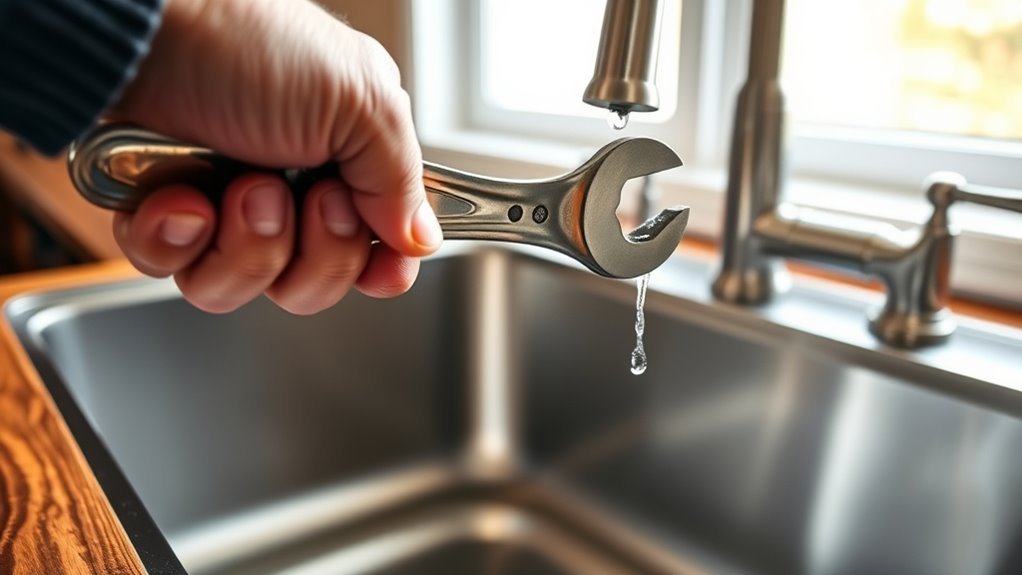Removing Sink From Wood Effectively
To remove a sink from wood effectively, start by turning off your water supply and clearing the area. Use the right tools—wrenches, screwdrivers, and a putty knife—to disconnect plumbing and loosen clips. Protect your wood countertop with padding, then carefully cut through sealant before lifting the sink out. After removal, clean and inspect the wood for damage to keep it in great shape. If you want to avoid common mistakes and protect your wood, there are useful tips and steps to follow next.
Tools and Materials Needed for Sink Removal

Before you begin removing a sink from wood, you’ll need a few essential tools and materials to make the process smooth and safe. Different sink types—like drop-in, undermount, or farmhouse—require specific removal techniques, so having the right gear is vital. Grab a wrench or adjustable pliers to disconnect plumbing, a putty knife to break sealants, and a utility knife for cutting caulk. A screwdriver helps remove mounting clips, and a bucket will catch any leftover water. Don’t forget safety gloves and goggles to protect yourself. Having these tools ready lets you work efficiently, giving you the freedom to tackle any sink type without hassle. Preparation is key to mastering removal techniques and ensuring your wood countertop stays intact.
Preparing the Wood Countertop for Sink Removal
Before you start removing the sink, make sure your workspace is clear and organized. Gather all the tools you’ll need so they’re within easy reach. Don’t forget to protect the wood surface to prevent any damage during the process.
Clear Workspace Setup
Although removing a sink from a wood countertop can be straightforward, you’ll need to clear your workspace thoroughly to avoid damage and make the process easier. Start by removing any items around the sink area to create room for movement and access. Organize tools and materials nearby but out of your immediate working zone to maintain workspace organization and prevent clutter. Make certain the area is well-lit and ventilated, giving you the freedom to work without restriction. Don’t forget essential safety precautions like wearing gloves and safety glasses to protect yourself from sharp edges or debris. Taking these steps guarantees a smooth removal process, preserving your wood countertop’s integrity while giving you the freedom to work confidently and efficiently in a safe, organized environment.
Gather Necessary Tools
Since removing a sink from a wood countertop requires careful handling, you’ll want to gather all the necessary tools beforehand to secure a smooth process. Start by collecting the essential tool types like a wrench, putty knife, screwdriver, and utility knife. Each tool plays a specific role—loosening plumbing connections, scraping sealant, and cutting caulk. Prioritize tool safety: wear gloves to protect your hands and goggles for eye safety. Inspect your tools to verify they’re in good condition, avoiding any accidents due to worn or damaged equipment. Having everything ready not only speeds up the job but also gives you the freedom to work confidently without interruptions. Preparing well means you can focus on removing the sink efficiently while preserving your wood countertop’s integrity.
Protect Wood Surface
Once you’ve gathered all your tools, the next step is to protect the wood surface around the sink. You want to take preventative measures to avoid scratches, stains, or accidental damage to your countertop. Start by clearing the area and wiping the wood clean. Lay down a protective covering like a thick drop cloth or foam padding to shield the surface from falling tools or debris. Use painter’s tape along the edges to hold the covering in place without harming the finish. These simple steps of wood surface protection guarantee your countertop stays pristine throughout the sink removal. By preparing carefully, you maintain the freedom to work confidently, knowing your wood won’t suffer any unintended harm during the process.
Turning Off Water Supply and Disconnecting Plumbing
Before you start removing the sink, you’ll need to turn off the water supply to prevent leaks and water damage. This step gives you control and peace of mind as you work. Locate the shut-off valves under the sink or turn off the main water supply if necessary. Once the water supply is off, carefully disconnect the plumbing connections, including the water lines and drain pipes.
Here’s what you should do:
- Turn off cold and hot water supply valves
- Open the faucet to drain remaining water
- Use a wrench to loosen plumbing connections gently
- Place a bucket underneath to catch drips
- Disconnect water supply lines and drain pipes carefully
Taking these steps guarantees a smooth, mess-free removal, giving you the freedom to proceed confidently.
Loosening and Removing Sink Clips or Fasteners

After turning off the water supply and disconnecting the plumbing, you can focus on freeing the sink from its mounting. The key lies in loosening and removing the sink fasteners that hold it firmly in place. These fasteners often take the form of clips underneath the sink basin. To start, grab a screwdriver or wrench that fits your sink fasteners snugly. Carefully loosen each clip, turning counterclockwise, and keep them organized so you don’t lose any. Clip removal can be a bit stubborn, so apply steady pressure without forcing it to avoid damage. Once all clips are free, your sink will feel less anchored, giving you the freedom to proceed with the next removal steps confidently.
Detaching the Sink Sealant and Removing the Sink
Start by carefully cutting through the sealant that holds your sink to the countertop. Mastering sink sealant removal is key to freeing your sink without damage. Use sink detachment techniques that prioritize gentle, controlled movements to avoid harming your wood surface. Here’s how to proceed:
- Use a utility knife or putty knife to slice through the sealant.
- Work slowly around the sink’s perimeter to avoid chipping the wood.
- Gently pry the sink upward once the sealant is cut.
- If resistance remains, check for hidden fasteners or sealant patches.
- Lift the sink steadily to prevent sudden drops or damage.
Following these steps empowers you to reclaim your countertop’s freedom while removing the sink cleanly and safely.
Cleaning and Inspecting the Wood Countertop After Removal

Once the sink is removed, your attention should turn to cleaning and inspecting the wood countertop. Start by wiping away any debris, old sealant, or water spots using a gentle cleaner that won’t damage the wood. This surface inspection is vital—you want to spot any cracks, stains, or water damage early. Look closely at edges and corners where moisture tends to hide. If you find any issues, address them before moving forward. Applying an appropriate wood treatment will help restore the wood’s resilience and prepare it for future use. Don’t rush this step; a thorough cleaning and careful surface inspection guarantee your countertop stays strong and beautiful, giving you the freedom to enjoy your space without worry.
Tips for Preventing Damage to Wood During Sink Removal
Although removing a sink can be a straightforward task, you’ll want to take specific precautions to protect your wood countertop from damage. Prioritizing wood preservation during sink replacement not only keeps your countertop looking great but also extends its life. Here are some tips to help you avoid scratches, dents, or water damage:
- Use protective padding or cloth under tools to prevent surface marks.
- Turn off water supply and disconnect plumbing carefully to avoid sudden pulls.
- Remove sink clips gently, avoiding forced prying that can chip wood.
- Wipe any water spills immediately to prevent wood swelling or stains.
- Work slowly and methodically, giving yourself room to maneuver without rushing.
Frequently Asked Questions
Can I Remove a Sink Without Professional Help?
You can definitely remove a sink without professional help if you’re willing to get your hands dirty. With the right sink removal tools and a bit of DIY plumbing know-how, you’ll free yourself from relying on costly services. Just make sure you turn off the water supply first, disconnect the plumbing carefully, and follow step-by-step guides. It’s empowering to take control and save money while learning new skills!
How Long Does Sink Removal Typically Take?
The sink removal timeline usually ranges from one to three hours, depending on several factors affecting duration. If you’re dealing with simple plumbing and a standard sink, you’ll likely be done quickly. But if there’s stubborn caulking, old pipes, or damage, it could take longer. You don’t have to rush—taking your time means doing it right and enjoying the freedom of handling the project yourself.
What Safety Precautions Should I Follow During Sink Removal?
When you’re tackling sink removal, safety gear is a must—think gloves and goggles to protect your hands and eyes. You’ll also want to use the right plumbing tools to avoid slips or damage. Make sure to turn off the water supply before starting, so you don’t get any surprises. Taking these precautions helps you work confidently and freely, without worrying about injuries or unexpected leaks messing up your project.
Can I Reuse the Old Sink After Removal?
They say, “One man’s trash is another man’s treasure,” and that applies to your old sink. You can definitely reuse it by exploring sink restoration techniques like thorough cleaning, resealing, or refinishing. Sink reuse benefits include saving money, reducing waste, and keeping a unique style in your space. By restoring rather than replacing, you embrace freedom from unnecessary costs and contribute to a sustainable lifestyle. It’s a win-win!
How Do I Dispose of the Old Sink Properly?
When you’re ready to get rid of your old sink, make sure you follow local disposal regulations to avoid fines. Since many sinks are made of metal, recycling metal is a smart choice that frees you from waste guilt and helps the environment. Check if your community has a metal recycling center or a special collection day. This way, you’re responsibly disposing of your sink while embracing your freedom to care for the planet.






